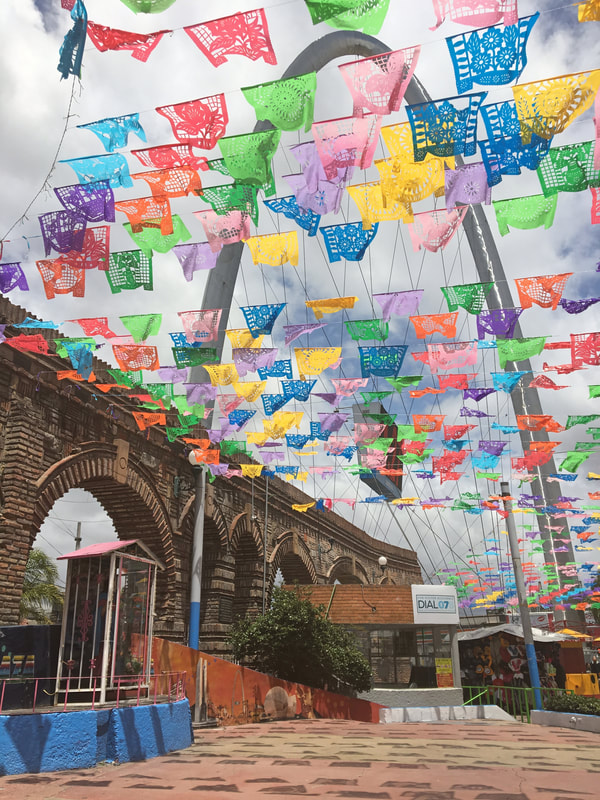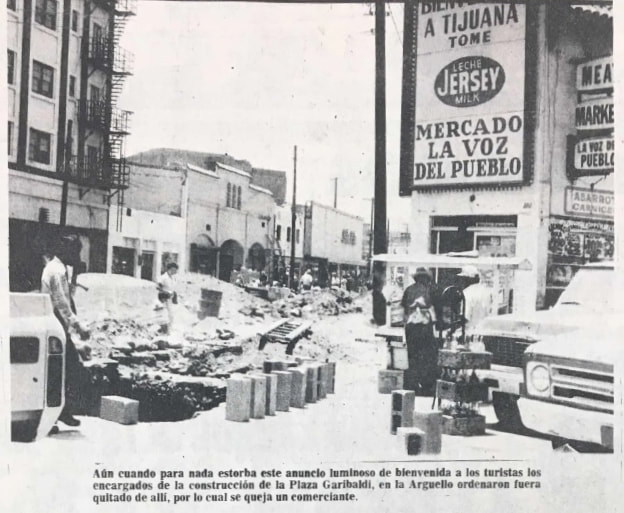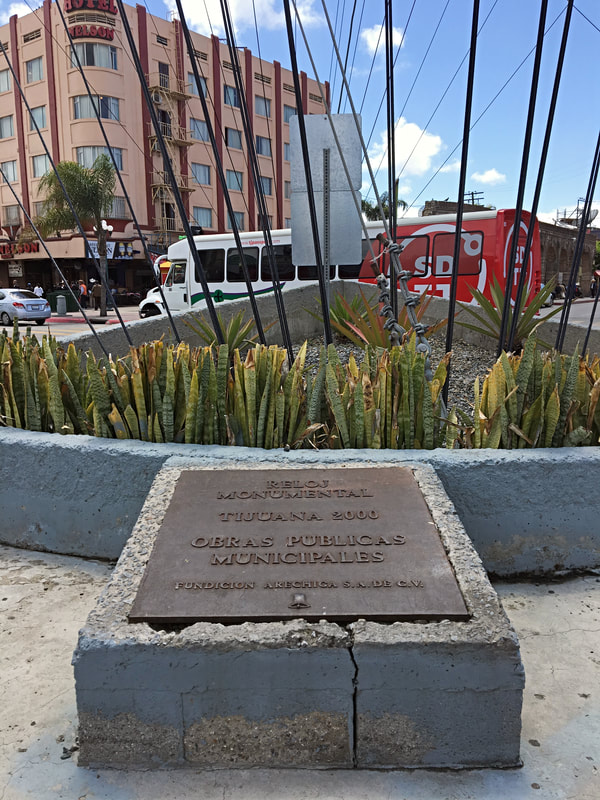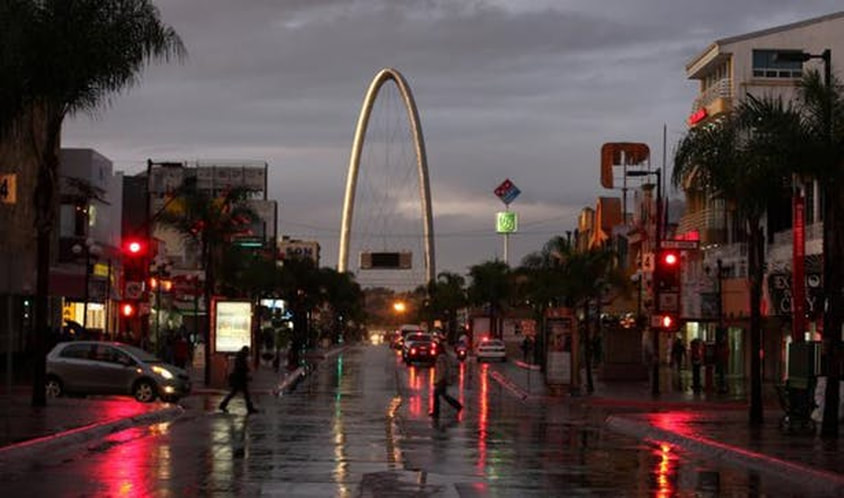|
A tall shining metallic arch rises above the busy streets and rolling hills of Tijuana, Baja California, giving Mexico’s westernmost city an icon to welcome visitors and to symbolize its modernity. It is called by various names, including the Arco del Milenio (Millennium Arch) or Arco de Tijuana, but officially the arch is known as the Reloj Monumental de Tijuana (Tijuana Monumental Clock). The arch has been controversial since its construction but has also become one of the city’s most important symbols in the 21st Century. [1] Arching Towards the PastMeasuring 196 feet (60 meters) in height and 110 feet (33.5 meters) wide, the Reloj Monumental is about a tall as a 14 story building, making the metallic arch easily visible throughout Tijuana as well as just across the U.S.-Mexico border in southwestern San Diego County. The towering arch was built specifically on Avenida Revolución (Tijuana’s most famous street) to welcome tourists. [2] The Reloj Monumental was first proposed by Tijuana Mayor Francisco “Kiko” Vega de Lamadrid early in his three-year (1998-2001) term to welcome the new millennium through a revitalization of Avenida Revolución and the city’s historic Plaza Santa Cecilia. The cabildo (or “city council”) formed a committee of local citizens to determine the project’s design through a contest. The winning design was the “Reloj Monumental Tijuana 2000” proposal by architects Leodegario Silva López, Edgar Iván Rodríguez Llerenas and Moisés López Smith. Their proposal featured a steel arch structure with copper construction.
The arch project was budgeted at $6,400,000 pesos (about $640,000 U.S. dollars) a small figure in comparison to the sums U.S. cities often pay for various urban projects, but a high investment for a city like Tijuana where many neighborhoods lacked access to electricity and sewage service. “I believe there are lots of things lacking in the city, and this won't solve downtown's problems,” councilwoman Yolanda Enriquez said, “which include dealing with the children in the streets, trash and the influx of vendors.” [5] Many businesses around Avenida Revolución and Plaza Santa Cecilia opposed the project fearing it would damage the historic center’s architectural integrity as well as the disruption construction would cause. Indeed, the arch was built over Avenida Revolución with its bases built on the northwestern and southeastern corners of its intersection with Calle Primera (Argüello). For much of the day the arch casts a shadow over the historic Plaza Santa Cecilia. Today the Plaza Santa Cecilia hosts various restaurants and shops while also being a favorite gathering place for mariachi musicians. Harkening back to the city’s early touristic heritage, redevelopment of the plaza has long been a contentious issue for tijuanenses as seen below in a July 5, 1980 story from the Heraldo de Baja California. Monumental ControversiesMayor Kiko Vega faced significant pushback against his Reloj Monumental. When the private financing the expensive project relied on did not materialize, Vega pushed the cabildo to fund construction until private groups could repay the city later. Although proposed as a tribute to Tijuana’s place in the new millennium, groundbreaking did not occur until December 31, 1999. Principal work did not begin until April 2000, by which point a municipal investigation discovered improprieties in how the project’s building contract was managed. Construction on the arch did not finish until October 2001. Kiko Vega kept the scandal-plagued project alive, completing it only on the last day of his term. On November 30, 2001, the Reloj Monumental was officially dedicated, although the project’s delays (and decreasing tourism after the September 11, 2001, terror attacks) greatly detracted from the moment’s festive mood. [6] As mayor of the state’s largest city, Vega pushed for the project to be completed to help his prospects as a gubernatorial candidate for the 2001 Baja California elections. Unsuccessful in the 2001 and 2007 elections, Kiko was finally elected governor for a six-year term in 2013. [7] The Reloj’s early years were a time of great frustration. While southbound motorists could see a “Welcome to Tijuana” sign suspended between the arch’s legs, the opposite side of the sign included a digital clock comprised of various small TV monitors. However, it stopped working just a few weeks after its dedication. [8]
In 2014 local merchants finally convinced Mayor Jorge Astiazarán Orcí to improve the monument’s upkeep as part of an effort to bring tourists back to the border city. The long-broken digital clock was replaced with a larger outdoor television donated by Samsung as part of the Korean corporation’s 5-year plan to invest $100 million U.S. dollars in the city. Corporate advertisements have run on the large monitor since it was installed in February 2015. [9] ConclusionAlthough many tijuanenses complain the arch is just an extravagant billboard, the arch’s renovation improved the Reloj Monumental’s reputation in the city, with tourism guides highlighting it as a key part of visiting the city. The arch is now a common reference point tijuanenses use when giving directions. “Lost? Head towards the arch.” [10] Although its controversial origins can in many ways be traced to Mayor Kiko Vega’s long-term political ambitions, there can be no doubt that nearly twenty years after its debut that the Reloj Monumental has become an essential part of 21st Century Tijuana and its historic Avenida Revolución. NOTES:[1] “El Arco del Milenio (Reloj Monumental Tijuana 2000),” Observatorio Turístico de Baja California (http://www.observaturbc.org/node/21735)
[2] Cesar Romero, “Arco Reloj Monumental,” Go App! MX (March 26, 2019), (https://www.goapp.mx/que-hacer-arco-reloj-monumental-792). [3] Joel Carrillo, “Reloj monumental – Tijuana, BC, MX,” ¿Soñando o la realidad? (March 26, 2012), (http://span413jcarrillo.umwblogs.org/2012/03/26/520/); “Reloj Monumental Tijuana 2000,” Archinect (https://archinect.com/pi9.arquitectos/project/reloj-monumental-tijuana-2000); Vega de Lamadrid photograph, Invest in Baja (http://www.investinbaja.gob.mx/en/vision/message-from-the-governor). [4] Carrillo, “Reloj monumental – Tijuana, BC, MX.” [5] Carrillo, “Reloj monumental – Tijuana, BC, MX,”; Anna Cearley, “Tijuana dedicates landmark in historic downtown core,” San Diego Union-Tribune, (Dec. 1, 2001), B-2, B-3. [6] Carrillo, “Reloj monumental – Tijuana, BC, MX,”; Anna Cearley, “Tijuana dedicates landmark in historic downtown core,” San Diego Union-Tribune, (Dec. 1, 2001), B-2, B-3; Ken Ellingwood, “Tijuana Monument Project Stalls,” Los Angeles Times (Dec. 12, 2000), (https://www.latimes.com/archives/la-xpm-2000-dec-12-mn-64405-story.html). [7] Kiko Vega was unsuccessful in gaining the support of Partido Accion Nacional (PAN) for the 2001 and 2007 gubernatorial elections in Baja California, and ultimately served in other political roles during those years. In 2013 Sonoran-born Vega finally succeeded in being nominated as PAN’s gubernatorial candidate and won that year’s race. Vega’s opaque reputation from his earlier term as mayor of Tijuana grew during his six-year term as governor through constant corruption scandals as well as a massively unpopular plan to privatize the water system in the Mexicali Valley. See Inés García Ramos, “Gobierno de “Kiko” desvió mil 432 millones de pesos,” Zeta, (Feb. 26, 2018), (https://zetatijuana.com/2018/02/gobierno-de-kiko-desvio-mil-432-millones-de-pesos/); Antonio Heras, “Continúan protestas por privatización del agua en Mexicali,” La Jornada (May 21, 2018), (https://www.jornada.com.mx/ultimas/2018/05/21/continuan-protestas-por-privatizacion-del-agua-en-mexicali-4984.html); Antonio Heras, “’Kiko’ Vega, el acaudalado gobernador… que nadie investiga,” Proceso (Nov. 24, 2016), (https://www.proceso.com.mx/463805/kiko-vega-acaudalado-gobernador-nadie-investiga) Eduardo Ruíz-Healy, “El decepcionante Kiko Vega,” Ruiz-Healy Times (Aug. 13, 2018), (https://www.ruizhealytimes.com/mi-columna/el-decepcionante-kiko-vega). [8] Carrillo, “Reloj monumental – Tijuana, BC, MX,”; Ángela Torres, “Inauguran pantalla en arco monumental,” La Jornada Baja California (Feb. 26, 2015), (http://jornadabc.mx/tijuana/26-02-2015/inauguran-pantalla-en-arco-monumental); UniRadio I,“ Piden quitar reloj monumental y dejar el arco,” YouTube (March 18, 2013), (https://www.youtube.com/watch?v=31_FI5Em3Sg). [9] “Donan pantalla gigante para Reloj Monumental,” AFN: Agencia Fronteriza de Noticias (Oct. 1, 2014), (http://www.afntijuana.info/informacion_general/32282_donan_pantalla_gigante_para_reloj_monumental). Jorge Astiazarán Orcí of the Institutional Revolutionary Party (PRI, Partido Institucional Revolucionario) served as Tijuana’s 24th mayor from 2013-2016. Samsung is one of the many TV-manufacturing firms based in Tijuana, formerly known as the “worldwide capital of television.” [10] Matthew Suárez, “Flat screen nation: Tijuana landmark gets monumentally sized TV set,” San Diego Reader (Feb. 19, 2015), (https://www.sandiegoreader.com/news/2015/feb/19/stringers-tijuana-flat-screen-el-arco-monument/). #Tijuana #BajaCalifornia #BC #Baja #ArcodeTijuana #RelojMonumental #Mexico #México #FronteraMexicoEEUU #USMexicoBorder #LaFrontera #Border #Borderlands #BorderHistory #BorderlandsHistory #HistoriaFronteriza #Arco #TJ #KikoVega
1 Comment
Rhea
1/31/2023 05:53:27
The arches have been my landmark to getting home safely across the border after a day shopping and celebrating down in Tijuana. No matter where you are in Tijuana, you can usually see the arches and if you can't, you won't miss them once you set your eyes on them. It's a great landmark. Sad about the clock. I think the clock is more appropriate....
Reply
Leave a Reply. |
Carlos Parra
U.S.-Mexican, Latino, and Border Historian Archives
January 2021
Categories
All
|














 RSS Feed
RSS Feed